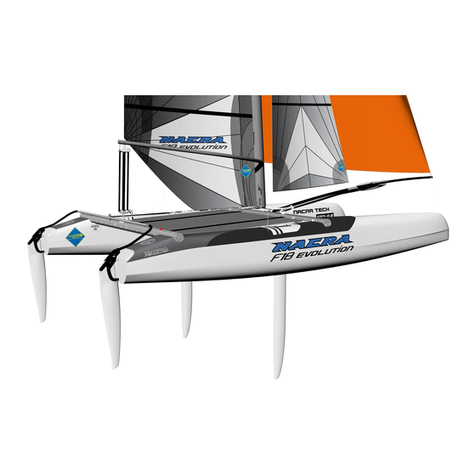7
B E F O R E Y O U G O S A I L I N G
Thoroughly check your protecve equipment to make
sure it is in working order and in good condion.
A frequently inspecon of the Nacra and the systems
should be made in order to idenfy punctures, tears or
any abrasions.
Check the trapeze wires on any wear and breakages,
parcularly the ropes of the trapeze system and on wear
and the knots in the ropes.
Secure the drain plugs before sailing and ensure that the
hulls are free of water. Ensure that any hatches are cor-
rectly ed and have a good seal;
Carry your Nacra or use beach wheels with cradles when-
ever possible to minimize keel wear;
Make sure a third party knows where you are sailing and
how many people accompany you;
Always check the condion of your cra before seng
o.
S A I L I N G A N D B E A C H IN G
NEVER sail above your ability or that of your crew;
A sailor’s safety knife should be carried on board;
When launching through the surf, always make sure the
bow is facing the waves.
Always know the direcon that the wind is blow-
ing;Watch out for changing weather condions;
Ensure that you and your crew can cope with any
changes in the weather condions;
Aer sailing, remove drain plugs to equalize the pressure
in the hulls, if no drain plugs installed, open the hatches;
Understand and be competent in the sailing skills and
righng techniques.
RIGHTING AFTER A CAPSIZE
Even the best sailors capsize occasionally, so prepare your-
self and the boat for the inevitable. Install a righng line
onto the dolphin striker rod below the mast.
The boat will lose speed as it raises up on one hull and usu-
ally capsizes over slowly. Hang on to the boat, being careful
not to separate yourself from the boat if possible.
As the boat capsizes you may be located in the water or on
the top hull above the water, try to get as fast as possible
onto the boom hull. It is important to get yourself to the
boom hull as quickly as possible to prevent the boat from
turning upside down (turtle).
Do NOT let go of the boat, as the current and the wind
may make it hard or impossible to get back onto the
boat.
Release the main, jib and spinnaker sheets. Reach around
the front crossbar, and throw the righng line over the top
hull. Make sure that the bows of the hulls are facing into the
wind. Move your weight towards the bow to turn the boat
to obtain the proper angle. Be careful not to shi your com-
bined weight too far forward or aerwards as this may
cause the boat to roll over and turn turtle. If the mast is
pointed directly into the wind, the boat may turn over to the
other side when you get the boat upright
Standing even with the front crossbar, the skipper and crew
should grab the righng line, and hike out backwards. You
can e knots in the righng line to prevent your hands from
slipping during this procedure. If you are single handling,
you may need to carry a righng bag to aain the necessary
weight to the boat upright.
Once the p of the mast starts to come out of the water, the
boat will right quickly. Be sure to hold onto the righng line
unl you can grab the boat and pull yourself up onto the
deck. Be careful to avoid being hit by the dolphin striker as
the boat comes down on top of you.
One of the crew should reboard over the front beam of the
catamaran onto the plaorm to ensure that the cra can
not sail away without the crew. The remaining crew can be
recovered by the side with the aid of the trapeze wires or
crew. Stow the righng line, organize the sheets, and you
are sailing again!
Minimum crew weight required for righng:
Nacra F20 Carbon 150 kg
WARNING!
Check for overhead cables when raising or lower-
ing the mast, launching and sailing the boat. So
look up when moving the cra around and give
any wires a wide berth. A mast which comes in
contact with electrical power lines can cause seri-
ous injury or death!
WARNING!
CAPSIZE RECOVERY
Recover the Nacra FCS as any normal catamaran, by
righng it as described in the Owner’s Manual.
AVOID physical contact with any sharp ends of the
daggerboards.
NEVER place yourself in a situaon were you could be
in danger of the daggerboards.
Before righng the Catamaran please make sure:
Main traveller-, mainsail- and jibsheet is released.
Bows are facing into the wind
Both daggerboards are pulled fully down and
secured by the trimming lines properly cleated in
their cleats

































